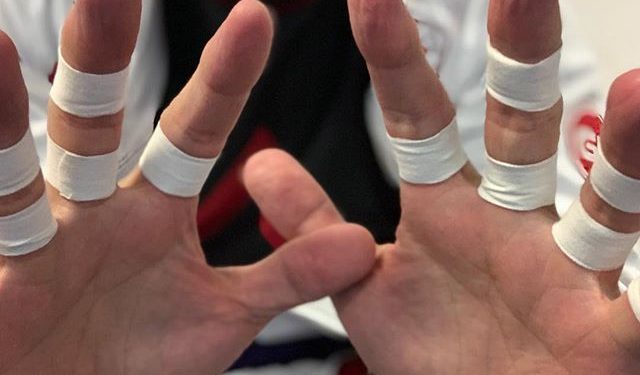As a spider guard and collar/sleeve player I quickly adopted the habit of using finger tape before stepping on to the BJJ mats. I have always felt I got a benefit out of taping my hands but I was curious if the perceived benefit had any basis in fact. I decided to look into the scientific research on taping hands/fingers to see what was being discussed in the academic literature. The closest comparisons to using finger tape in BJJ I could find in terms of published studies were done examining the efficacy of finger taping in regards to rock climbers taping their hands after suffering a pulley tendon injury.
The basics of how finger taping works is to use a taping matrix to support the “pulley” tendons in your fingers. There are 8 individual pulleys with 2 major pulleys the “A2” and “A4”. These are the most bio-mechanically relevant pulleys and do the most to prevent an injury commonly referred to as “bowstringing” which involves a rupturing of a pulley tendon to the degree that the finger is still straight instead of folded when a fist is made.
A study completed in 2007, “Impact of “Taping” after Finger Flexor Tendon Pulley Ruptures in Rock Climbers” stated that “The new taping method decreased the tendon-bone distance in the injured finger significantly by 16%, whereas the other taping methods did not. The strength development was significantly better with the new tape for the crimp grip position (+13%)”. This technique is known as the “H”method where tape is banded above and below the large knuckle in the finger and the crossed over creating a “H” shape. This study did not show any significant improvement for athletes with healthy fingers – only those who were training through an injury and used tape saw a significant difference in performance with tape than without it.
Another study done in 2000 “Biomechanical effectiveness of taping the A2 pulley in rock climbers” presented data that showed when using circular taping techniques (simply looping tape around the finger) that “Taping over the A2 pulley decreased bowstringing by 2.8% and absorbed 11% of the force of bowstringing. Taping over the distal end of the proximal phalanx decreased bowstringing by 22% and absorbed 12% of the total force.”This study also concluded that prophylactic taping was not only minimally effective but not recommended.
I reached out to Doctor of Physical Therapy Eric Abramowitz, a movement and injury specialist that has a large portion of his practice dedicated to combat sports rehab. When asked on his thoughts about prophylactic finger taping he had this to say:
“[The following advice is non-specific to a particular diagnosis. These are fundamental concepts that need to be individualized when applied. If you are someone with a history of finger or hand issues, it’s recommended that you work with a trusted medical professional to determine what, if any, bracing techniques are best to support the compromised structures.]
If you have a history of finger/hand injuries, it’s time to develop adequate strength / intrinsic stability of your fingers by incorporating lighter training sessions with less or no taping to work toward that goal; Both in the gym lifting weights and on the mats. If you’re expecting long, high strain days, or that your recovery has been less than ideal, these are the sessions that likely warrant the use of tape while training.
For the healthy crowd in BJJ with no history of injury, I’m not so sure that applying finger tape is answer. It’s within your best interest to focus on developing a training regimen that integrates appropriate load and strain for what your body can currently handle.
With that said, we’re talking about Jiu-Jitsu. A sport where accidents happen and positions get away from you in an instant and before you know it, it could be too late. It’s important to go into every training session knowing that you are responsible for the health and well-being of not only yourself, but your training partners.”
Click here to learn more about Dr. Eric Abramowitz.
Takeaways from the above:
- Prophylactic taping with no history of injury may not be helpful unless your training volume is high and amount of recovery time is low
- “H” taping your fingers has been shown to be effective in two studies that showed an increase in measured finger strength and prevented re-injury in a significant manner.
- Improving hand and finger strength needs to be a priority in conjunction with using tape in BJJ training after suffering finger/hand injuries.
- Be aware of both your own and your training partners injuries to prevent future injuries.












